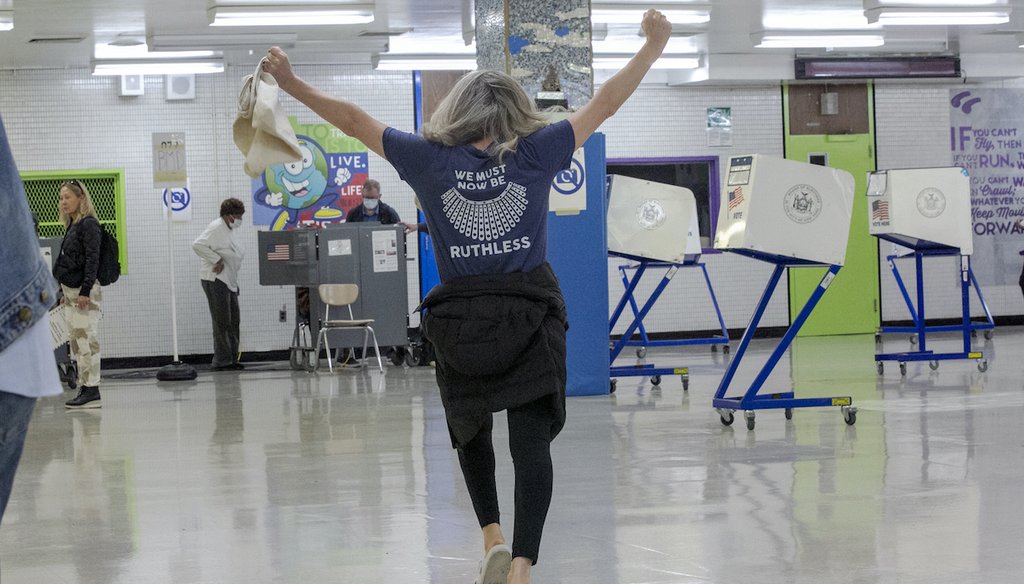Stand up for the facts!
Our only agenda is to publish the truth so you can be an informed participant in democracy.
We need your help.
I would like to contribute

A voter wearing a Ruth Bader Ginsburg t-shirt is at an early voting polling site at Frank McCourt High School on the Upper West Side of Manhattan in New York City on Tuesday, November 1, 2022. (AP)
Instagram post wrongly says most eligible voters don’t vote
If Your Time is short
-
In 2018, 50% of eligible voters cast a ballot.
-
In 2020, overall turnout was 66.7%.
-
Catalist, a company that provides data to Democrats, told PolitiFact on Nov. 2 that pre-Election Day voting at this point has surpassed the same time in 2018.
One week before the midterms, social media users are trying to drum up voter turnout. One Instagram post suggests turnout is lagging behind 2018 and that most people who are eligible to vote don’t do so.
A Nov. 1 Instagram post includes a cartoon drawing of a bunch of people. About one-third of the people (on the left side of the image) are smiling and wearing a white T-shirt that said, "I voted." The rest are to the right, looking serious and with plain white T-shirts. Below all of them is text that said, "two thirds of eligible voters don’t vote."
"Vote people. Damn! Voting is down from 2018," the post’s caption said.
This post was flagged as part of Facebook’s efforts to combat false news and misinformation on its News Feed. (Read more about our partnership with Meta, which owns Facebook and Instagram.)
Michael McDonald, a professor at the University of Florida, tracks pre-Election Day turnout for his United States Elections Project. As of midday Nov. 2, more than 29 million people had voted nationwide, by mail or in person, McDonald found.
McDonald said that in 2018, 50% of eligible voters cast a ballot, the highest turnout since 1914. That refutes the post’s claim that 66% of eligible voters don’t vote.
In 2020, overall turnout was 66.7% — so two-thirds of eligible voters cast ballots in that election, the opposite of what the post claimed.
Catalist, a company that provides data to Democratic groups or politicians, told PolitiFact on Nov. 2 that at least 25.3 million people had voted by mail or in person for the November election. That exceeds 2018, when 23.7 million ballots were cast by that same date before Election Day. Catalist's data lags publicly reported totals from secretaries of state, but it shows that voting for the current election is not lagging 2018.
"This is consistent with a high-turnout midterm, but whether it will break 2018's record will come down to Election Day voting," said Catalist spokesperson Aaron Huertas.
Every state sets their own laws about whether and when they have early voting, as well as who can obtain a mail ballot. That means pre-Election Day voting is heavier in some states than in others.
Due to states that changed laws about early or mail voting after the 2018 election, it’s not a perfect comparison to look at 2022 data. In 2018, for example, only Pennsylvania voters with an excuse such as being out of town were allowed to cast an absentee ballot. But in 2019, the General Assembly passed a law allowing any voter to cast a mail ballot.
"The two main things that make apples-to-apples comparisons difficult are changes to voting laws and whether a given state has a competitive election, particularly at the statewide level," Huertas said. "And, of course, a midterm will have lower turnout than a presidential year."
We won’t have a complete picture about how pre-Election Day voting in 2022 compares to 2018 until in-person early voting is over and the deadlines pass for submitting mail ballots.
For voters who want to track turnout in their local jurisdictions, many state and local election offices regularly post updated turnout statistics. For example, Florida counties upload daily reports showing early voting turnout by county.
Our ruling
An Instagram post said that "two thirds of eligible voters don’t vote."
It’s unclear if the post relied on 2020 presidential or 2018 midterm election data, but either way, it is wrong. In 2018, ultimately 50% of eligible voters cast a ballot. In 2020, two-thirds did cast a ballot.
We rate this statement False.
Our Sources
Instagram post, Nov. 2, 2022
Michael McDonald, University of Florida, 2022 General Election Early Voting Statistics, Data as of 12:36 p.m. Nov. 2, 2022
CNN, Pre-election voting is surpassing 2018 levels with more than 21 million ballots cast, Oct. 31, 2022
Pew Research Center, Turnout soared in 2020 as nearly two-thirds of eligible U.S. voters cast ballots for president, Jan. 28, 2021
Georgia Secretary of State Brad Raffensperger, Statement to media about pre Election Day turnout, Nov. 2, 2022
Email interview, Catalist spokesperson Aaron Huertas, Nov. 2, 2022
Email interview, Michael McDonald, University of Florida professor of political science , Nov. 2, 2022
Browse the Truth-O-Meter
More by Amy Sherman
Instagram post wrongly says most eligible voters don’t vote
Support independent fact-checking.
Become a member!
In a world of wild talk and fake news, help us stand up for the facts.
















































